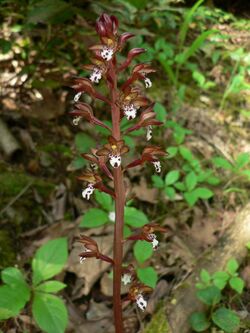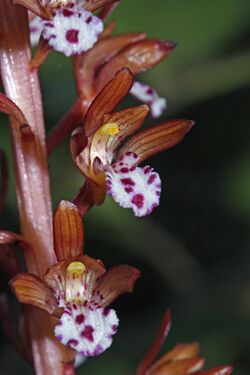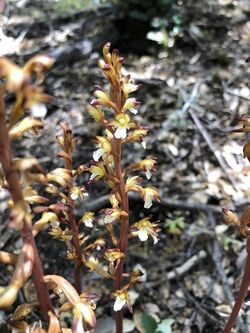Biology:Corallorhiza maculata
| Corallorhiza maculata | |
|---|---|

| |
| Corallorhiza maculata var. maculata | |
| Scientific classification | |
| Kingdom: | Plantae |
| Clade: | Tracheophytes |
| Clade: | Angiosperms |
| Clade: | Monocots |
| Order: | Asparagales |
| Family: | Orchidaceae |
| Subfamily: | Epidendroideae |
| Genus: | Corallorhiza |
| Species: | C. maculata
|
| Binomial name | |
| Corallorhiza maculata Raf.
| |
| Synonyms[1] | |
| |
Corallorhiza maculata, or spotted coralroot, is a North American coralroot orchid.[2] It has four varieties: C. maculata var. occidentalis (western spotted coralroot), C. maculata var. maculata (eastern spotted coralroot or summer coralroot), C. maculata var. mexicana, and C. maculata var. ozettensis. It is widespread through Mexico, Guatemala, Canada , St. Pierre & Miquelon, and much of the western and northern United States (though generally absent from the Great Plains and from the lowland parts of the Southeast). It grows mostly in montane woodlands.[3][4][5]
Description
Corallorhiza maculata is a myco-heterotroph; it lacks chlorophyll and obtains energy by parasitizing the mycelium of fungi in the family Russulaceae. The rhizome and lower stem are often knotted into branched coral shapes. The stem is usually red or brown in color, but occasionally comes in a light yellow or cream color. There are no leaves and no photosynthetic green tissues. The stems bear dark red scales and intricate orchid flowers.
Corallorhiza maculata flowers are small and emerge regularly from all sides of the stem. The sepals are dark red or brown tinged with purple, long and pointed. The side petals are reddish, and the lip petal is bright clean white with deep red spots. It is usually scalloped along its edges and 7–10 mm (9⁄32–13⁄32 in). In some varieties, the lip may be plain white without spots.
Uses
Several Native American groups historically used the orchid's stems dried and brewed as a tea for such maladies as colds, pneumonia, and skin irritation.
Corallorhiza maculata is also the topic of the poem On Going Unnoticed by Robert Frost.
References
- ↑ "Corallorhiza maculata". World Checklist of Selected Plant Families (WCSP). Royal Botanic Gardens, Kew. http://wcsp.science.kew.org/namedetail.do?name_id=47047.
- ↑ Wiese, Karen (2013). Sierra Nevada Wildflowers (2nd ed.). p. 99.
- ↑ "Corallorhiza maculata". World Checklist of Selected Plant Families (WCSP). Royal Botanic Gardens, Kew. http://wcsp.science.kew.org/qsearch.do?page=quickSearch&plantName=Corallorhiza%2Bmaculata.
- ↑ "Corallorhiza maculata", County-level distribution map from the North American Plant Atlas (NAPA) (Biota of North America Program (BONAP)), 2014, http://bonap.net/MapGallery/County/Corallorhiza%20maculata.png
- ↑ Magrath, Lawrence K.; Freudenstein, John V. (2002), "Corallorhiza maculata", in Flora of North America Editorial Committee, Flora of North America North of Mexico (FNA), 26, New York and Oxford, http://www.efloras.org/florataxon.aspx?flora_id=1&taxon_id=
Further reading
- Taylor, D.L. & T.D. Bruns. (1997). Independent, specialized invasions of ectomycorrhizal mutualism by two nonphotosynthetic orchids. Proc. Natl. Acad. Sci. USA vol. 94 pp. 4510–4515.
External links
Wikidata ☰ Q2996998 entry
 |



